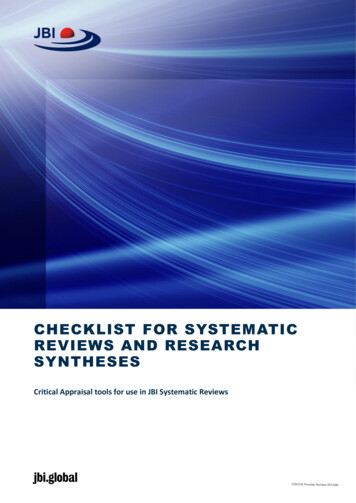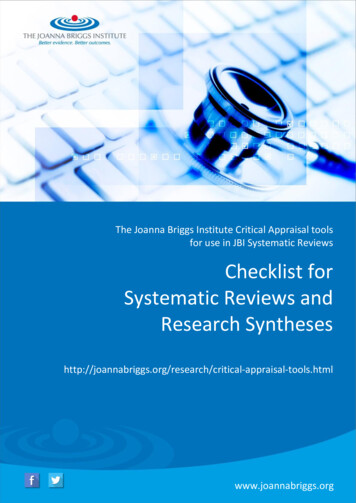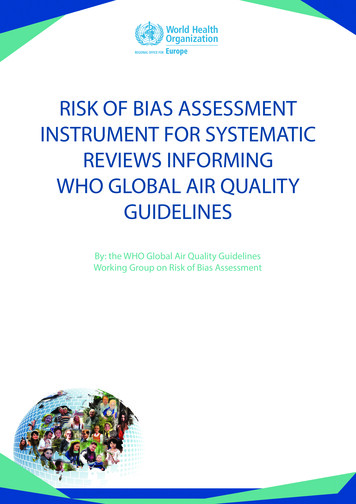
Transcription
CHECKLIST FOR SYSTEMATICREVIEWS AND RESEARCHSYNTHESESCritical Appraisal tools for use in JBI Systematic Reviews
INTRODUCTIONJBI is an international research organisation based in the Faculty of Health and Medical Sciences at theUniversity of Adelaide, South Australia. JBI develops and delivers unique evidence-based information,software, education and training designed to improve healthcare practice and health outcomes. With over70 Collaborating Entities, servicing over 90 countries, JBI is a recognised global leader in evidence-basedhealthcare.JBI Systematic ReviewsThe core of evidence synthesis is the systematic review of literature of a particular intervention, conditionor issue. The systematic review is essentially an analysis of the available literature (that is, evidence) and ajudgment of the effectiveness or otherwise of a practice, involving a series of complex steps. JBI takes aparticular view on what counts as evidence and the methods utilised to synthesise those different types ofevidence. In line with this broader view of evidence, JBI has developed theories, methodologies andrigorous processes for the critical appraisal and synthesis of these diverse forms of evidence in order to aidin clinical decision-making in healthcare. There now exists JBI guidance for conducting reviews ofeffectiveness research, qualitative research, prevalence/incidence, etiology/risk, economic evaluations,text/opinion, diagnostic test accuracy, mixed-methods, umbrella reviews and scoping reviews. Furtherinformation regarding JBI systematic reviews can be found in the JBI Evidence Synthesis Manual.JBI Critical Appraisal ToolsAll systematic reviews incorporate a process of critique or appraisal of the research evidence. The purposeof this appraisal is to assess the methodological quality of a study and to determine the extent to which astudy has addressed the possibility of bias in its design, conduct and analysis. All papers selected forinclusion in the systematic review (that is – those that meet the inclusion criteria described in the protocol)need to be subjected to rigorous appraisal by two critical appraisers. The results of this appraisal can thenbe used to inform synthesis and interpretation of the results of the study. JBI Critical appraisal tools havebeen developed by the JBI and collaborators and approved by the JBI Scientific Committee followingextensive peer review. Although designed for use in systematic reviews, JBI critical appraisal tools can alsobe used when creating Critically Appraised Topics (CAT), in journal clubs and as an educational tool.Critical Appraisal Checklist for Systematic Reviews and Research Syntheses - 2
JBI CRITICAL APPRAISAL CHECKLIST FORSYSTEMATIC REVIEWS AND RESEARCH SYNTHESESReviewer DateAuthor Year Record Number1.Is the review question clearly and explicitly stated?2.Were the inclusion criteria appropriate for the reviewquestion?3.Was the search strategy appropriate?4.Were the sources and resources used to search forstudies adequate?5.Were the criteria for appraising studies appropriate?6.Was critical appraisal conducted by two or morereviewers independently?7.Were there methods to minimize errors in dataextraction?8.Were the methods used to combine studies appropriate?9.Was the likelihood of publication bias assessed?10. Were recommendations for policy and/or practicesupported by the reported data?11. Were the specific directives for new researchappropriate?Overall appraisal:Include Exclude YesNoUnclearNotapplicable Seek further infoComments (Including reason for exclusion)Critical Appraisal Checklist for Systematic Reviews and Research Syntheses - 3
JBI CRITICAL APPRAISAL CHECKLIST FOR SYSTEMATICREVIEWS AND RESEARCH SYNTHESISHow to cite: Aromataris E, Fernandez R, Godfrey C, Holly C, Kahlil H, Tungpunkom P. Summarizingsystematic reviews: methodological development, conduct and reporting of an Umbrella review approach.Int J Evid Based Healthc. 2015;13(3):132-40.When conducting an umbrella review using the JBI method, the critical appraisal instrument for SystematicReviews should be used.The primary and secondary reviewer should discuss each item in the appraisal instrument for each studyincluded in their review. In particular, discussions should focus on what is considered acceptable to theaims of the review in terms of the specific study characteristics. When appraising systematic reviews thisdiscussion may include issues such as what represents an adequate search strategy or appropriate methodsof synthesis. The reviewers should be clear on what constitutes acceptable levels of information to allocatea positive appraisal compared with a negative, or response of “unclear”. This discussion should ideally takeplace before the reviewers independently conduct the appraisal.Within umbrella reviews, quantitative or qualitative systematic reviews may be incorporated, as well asmeta-analyses of existing research. There are 11 questions to guide the appraisal of systematic reviews ormeta-analyses. Each question should be answered as “yes”, “no”, or “unclear”. Not applicable “NA” is alsoprovided as an option and may be appropriate in rare instances.1. Is the review question clearly and explicitly stated?The review question is an essential step in the systematic review process. A well-articulatedquestion defines the scope of the review and aids in the development of the search strategy tolocate the relevant evidence. An explicitly stated question, formulated around its PICO (Population,Intervention, Comparator, Outcome) elements aids both the review team in the conduct of thereview and the reader in determining if the review has achieved its objectives. Ideally the reviewquestion should be articulated in a published protocol; however this will not always be the casewith many reviews that are located.2. Were the inclusion criteria appropriate for the review question?The inclusion criteria should be identifiable from, and match the review question. The necessaryelements of the PICO should be explicit and clearly defined. The inclusion criteria should be detailedand the included reviews should clearly be eligible when matched against the stated inclusioncriteria. Appraisers of meta-analyses will find that inclusion criteria may include criteria around theability to conduct statistical analyses which would not be the norm for a systematic review. Thetypes of included studies should be relevant to the review question, for example, an umbrellareview aiming to summarize a range of effective non-pharmacological interventions for aggressivebehaviors amongst elderly patients with dementia will limit itself to including systematic reviewsand meta-analyses that synthesize quantitative studies assessing the various interventions;qualitative or economic reviews would not be included.3. Was the search strategy appropriate?A systematic review should provide evidence of the search strategy that has been used to locatethe evidence. This may be found in the methods section of the review report in some cases, or asan appendix that may be provided as supplementary information to the review publication. Asystematic review should present a clear search strategy that addresses each of the identifiablePICO components of the review question. Some reviews may also provide a description of theapproach to searching and how the terms that were ultimately used were derived, though due tolimits on word counts in journals this may be more the norm in online only publications. Thereshould be evidence of logical and relevant keywords and terms and also evidence that SubjectHeadings and Indexing terms have been used in the conduct of the search. Limits on the searchCritical Appraisal Checklist for Systematic Reviews and Research Syntheses - 4
should also be considered and their potential impact; for example, if a date limit was used, was thisappropriate and/or justified? If only English language studies were included, will such a languagebias have an impact on the review? The response to these considerations will depend, in part, onthe review question.4. Were the sources and resources used to search for studies adequate?A systematic review should attempt to identify “all” the available evidence and as such thereshould be evidence of a comprehensive search strategy. Multiple electronic databases should besearched including major bibliographic citation databases such as MEDLINE and CINAHL. Ideally,other databases that are relevant to the review question should also be searched, for example, asystematic review with a question about a physical therapy intervention should also look to searchthe PEDro database, whilst a review focusing on an educational intervention should also search theERIC. Reviews of effectiveness should aim to search trial registries. A comprehensive search is theideal way to minimize publication bias, as a result, a well conducted systematic review should alsoattempt to search for grey literature, or “unpublished” studies; this may involve searching websitesrelevant to the review question, or thesis repositories.5. Were the criteria for appraising studies appropriate?The systematic review should present a clear statement that critical appraisal was conducted andprovide the details of the items that were used to assess the included studies. This may bepresented in the methods of the review, as an appendix of supplementary information, or as areference to a source that can be located. The tools or instruments used should be appropriate forthe review question asked and the type of research conducted. For example, a systematic review ofeffectiveness should present a tool or instrument that addresses aspects of validity forexperimental studies and randomized controlled trials such as randomization and blinding – if thereview includes observational research to answer the same question a different tool would be moreappropriate. Similarly, a review assessing diagnostic test accuracy may refer to the recognizedQUADAS1 tool.6. Was critical appraisal conducted by two or more reviewers independently?Critical appraisal or some similar assessment of the quality of the literature included in a systematicreview is essential. A key characteristic to minimize bias or systematic error in the conduct of asystematic review is to have the critical appraisal of the included studies completed independentlyand in duplicate by members of the review team. The systematic review should present a clearstatement that critical appraisal was conducted by at least two reviewers working independentlyfrom each other and conferring where necessary to reach decision regarding study quality andeligibility on the basis of quality.7. Were there methods to minimize errors in data extraction?Efforts made by review authors during data extraction can also minimize bias or systematic errorsin the conduct of a systematic review. Strategies to minimize bias may include conducting all dataextraction in duplicate and independently, using specific tools or instruments to guide dataextraction and some evidence of piloting or training around their use.8. Were the methods used to combine studies appropriate?A synthesis of the evidence is a key feature of a systematic review. The synthesis that is presentedshould be appropriate for the review question and the stated type of systematic review andevidence it refers to. If a meta-analysis has been conducted this needs to be reviewed carefully.Was it appropriate to combine the studies? Have the reviewers assessed heterogeneity statisticallyand provided some explanation for heterogeneity that may be present? Often, whereheterogeneous studies are included in the systematic review, narrative synthesis will be anappropriate method for presenting the results of multiple studies. If a qualitative review, are theCritical Appraisal Checklist for Systematic Reviews and Research Syntheses - 5
methods that have been used to synthesize findings congruent with the stated methodology of thereview? Is there adequate descriptive and explanatory information to support the final synthesizedfindings that have been constructed from the findings sourced from the original research?9. Was the likelihood of publication bias assessed?As mentioned, a comprehensive search strategy is the best means by which a review author mayalleviate the impact of publication bias on the results of the review. Reviews may also presentstatistical tests such as Egger’s test or funnel plots to also assess the potential presence ofpublication bias and its potential impact on the results of the review. This question will not beapplicable to systematic reviews of qualitative evidence.10. Were recommendations for policy and/or practice supported by the reporteddata?Whilst the first nine (9) questions specifically look to identify potential bias in the conduct of asystematic review, the final questions are more indictors of review quality rather than validity.Ideally a review should present recommendations for policy and practice. Where theserecommendations are made there should be a clear link to the results of the review. Is thereevidence that the strength of the findings and the quality of the research been considered in theformulation of review recommendations?11. Were the specific directives for new research appropriate?The systematic review process is recognized for its ability to identify where gaps in the research, orknowledge base, around a particular topic exist. Most systematic review authors will provide someindication, often in the discussion section of the report, of where future research direction shouldlie. Where evidence is scarce or sample sizes that support overall estimates of effect are small andeffect estimates are imprecise, repeating similar research to those identified by the review may benecessary and appropriate. In other instances, the case for new research questions to investigatethe topic may be warranted.REFERENCES1. Whiting P, Rutjes AWS, Reitsma JB, Bossuyt PMM, Kleijnen J. The development of QUADAS: a toolfor the quality assessment of studies of diagnostic accuracy included in systematic reviews. BMCMedical Research Methodology. 2003;3:25 doi:10.1186/1471-2288-3-25.Critical Appraisal Checklist for Systematic Reviews and Research Syntheses - 6
1. Is the review question clearly and explicitly stated? The review question is an essential step in the systematic review process. A well-articulated question defines the scope of the review and aids in the development of the search strategy to locate the relevant evidence. An explicitly stated question, formulated around its PICO (Population,











